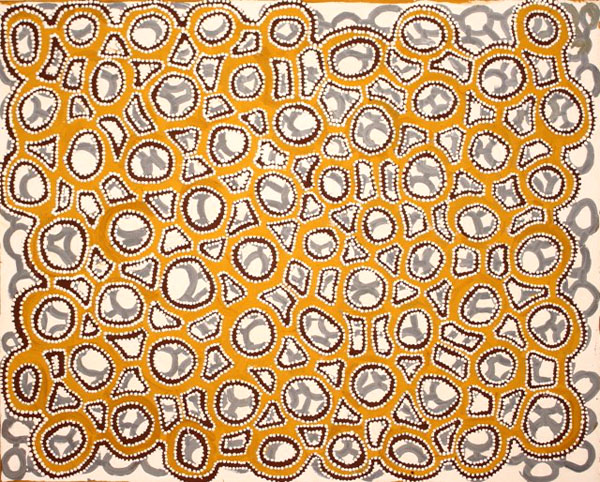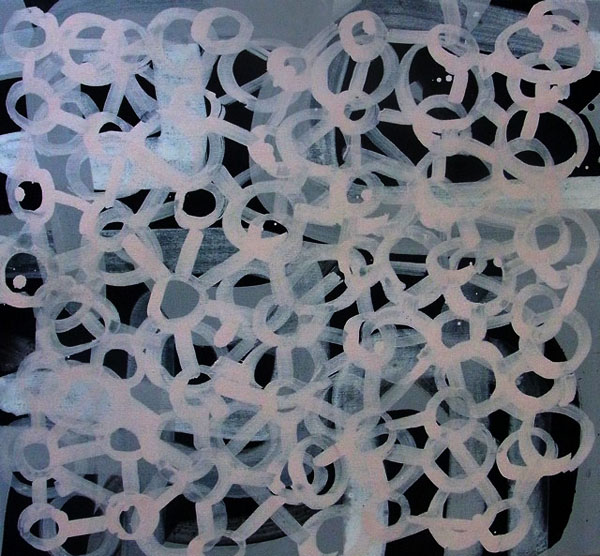
Kittey Malarvie, Luga – Cracked mud, 2013. Natural ochre and pigment on canvas, 100 x 80 cm. (#410212) © The Artist – Photo Courtesy Waringarri

Karen Mills, Sturt Creek (#2), 2013. Natural earth pigments on canvas, 61 x 56 cm. © IDAIA – Photo Courtesy Waringarri
In these conversational paintings Kittey Malarvie from Kununurra and Karen Mills from Darwin weave stylistic, intergenerational and intercultural affinities around an uncommon place. Unlike the art historical ‘conversation piece’, an agreeable and ephemeral arrangement of people in a landscape, preferably somewhere in Europe; here undulating and sometimes intersecting lines tell the history of country and echo the absence of its displaced people. As the culmination of Karen Mills’s artist in residency at Warringarri Aboriginal Arts, Kittey Malarvie showed her country, their shared country — the desert landscape around Lake Gregory, a desert lake whose cultural, historical, archeological and geological significance is remarkable.
Painting in the ochres of the country, the artists speculate on these intercultural and family affinities in a simultaneous translation of the language of the place and the strokes, genstures and utterances of international abstraction.
In early 2012 Karen Mills was the inaugural artist in residence at Waringarri Aboriginal Arts in Kununurra to learn from Waringarri’s ochre painters and to share her skills. In conversation with senior artist Kittey Malarvie they realised their relation through marriage. A relation through Kittey’s daughter’s fathers family to Paddy King, an Aboriginal leader. (Photographed by Axel Poignant as ‘Paddy King of Ord River, Western Australia’ in 1947.)
This led the camping trip in mid-2013 to Sturt Creek Station, north of the Great Sandy Desert, the land where Kittey grew up, learnt and played at on Nicholson Station and Sturt Creek Station. Along the way Kittey shared the stories of bush and life as pastoral workers. Karen Mills, grew up as an adopted child in Adelaide. They camped for two nights beside Sturt Creek, not far from the ruins of old Sturt Creek Station homestead where a massacre of local Aboriginal people had occurred in the early 1920s. The milk white waters of Sturt Creek, depicted by both artists, meld this uncommon family history and bless their inspirational meeting point.
Karen Mills says: Kittey was very happy that she had been able to see her country again. She said the Old People were watching over us and that they were happy because she had come back to visit them. In my heart I hoped the Old People were happy about me being there too. (Statement for Salon, Darwin Festival, August 2013.)
Kittey Malarvie says: It’s good we are together. / We were talking and discovered that we are related. / ‘Luga’ is a memory of the mud flats, it’s about being together, part of a family … playing hopscotch in the cracked mud. (Pers corr Cathy Cummins, curator.)
Karen Mills’s paintings are positioned on the edge between opposing and complementary territories of painting, between representation and abstraction, often using the motif of weaving. This is one of a series of exceptional exhibitions on ‘weaving history and connections’ in Darwin, Sydney and Dallas.
Kittey Malarvie’s lattice-like paintings reflect more than just the fractured striations of drying mud or of moving waters. They form a visual biography, recalling bush medicine and playing on dried riverbanks with siblings and cousins. She was recently the subject of a short monograph in Art Monthly Australia.
The idea of reconnecting artists, culture and history is not new, but the model being pioneered at Warringarri Arts is exceptional for this focus on connections as much as for expanding painting practice, experiment and opportunity. For almost three decades Waringarri Aboriginal Arts, initiated by artists such as Queenie McKenzie and Paddy Carlton, has expanded upon our understanding of east Kimberly painting and cultural traditions. This carefully curated search for excellence and innovation continues in these conversations.
A recurring motif at The Cross Art Projects looks at how artists make connections and communicate. Karen Mills co-curated ‘Twined’, an exhibition that was expanded to ‘Twining: Weaving and Abstraction, Dawes / Djunginy / Mills / MacDonald’ for 24hr Art, Darwin in 2011.
SOURCE: The Cross Art Projects Website